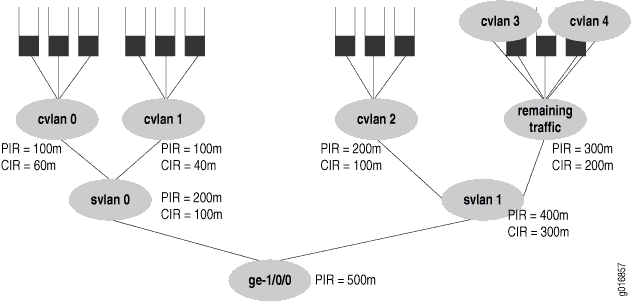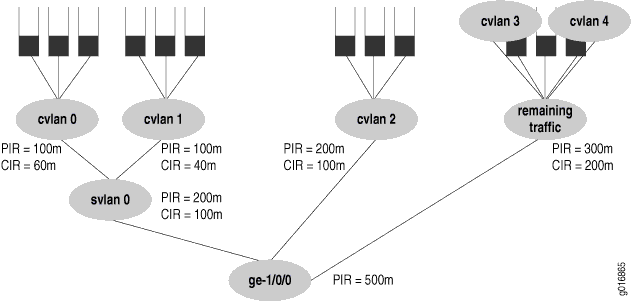ON THIS PAGE
Example: Controlling Remaining Traffic
This example shows how to control remaining traffic from the remaining logical interfaces.
Requirements
Before you begin:
Review how to configure schedulers. See Example: Configuring Class-of-Service Schedulers on a Security Device.
Review how to configure and apply scheduler maps. See Example: Configuring and Applying Scheduler Maps.
Overview
To configure transmit rate guarantees for the remaining traffic,
you configure the output-traffic-control-profile-remaining statement specifying a guaranteed rate for the remaining traffic.
Without this statement, the remaining traffic gets a default, minimal
bandwidth. Similarly, you can specify the shaping-rate and delay-buffer-rate statements in the traffic control profile
referenced with the output-traffic-control-profile-remaining statement to shape and provide buffering for remaining traffic.
In the interface shown in Figure 1, customer VLANs 3 and 4 have no explicit traffic control profile. However, the service provider might want to establish a shaping and guaranteed transmit rate for aggregate traffic heading for those C-VLANs. The solution is to configure and apply a traffic control profile for all remaining traffic on the interface.

Example 1 considers the case where C-VLANs 3 and 4 have no explicit
traffic control profile, yet need to establish a shaping and guaranteed
transmit rate for traffic heading for those C-VLANs. The solution
is to add a traffic control profile to the svlan1 interface
set. This example builds on the example used in Example: Configuring a Four-Level Scheduler Hierarchy and does not repeat all configuration details, only those at the
S-VLAN level.
Next, consider Example 2 shown in Figure 2.

In Example 2, ge-1/0/0 has five logical interfaces
(C-VLAN 0, 1, 2, 3 and 4), and S-VLAN 0, which are covered by the
interface set:
Scheduling for the interface set
svlan0is specified by referencing anoutput-traffic-control-profilestatement, which specifies theguaranteed-rate,shaping-rate, anddelay-buffer-ratestatement values for the interface set. In this example, the output traffic control profile calledtcp-svlan0guarantees 100 Mbps and shapes the interface setsvlan0to 200 Mbps.Scheduling and queuing for remaining traffic of
svlan0is specified by referencing anoutput-traffic-control-profile-remainingstatement, which references ascheduler-mapstatement that establishes queues for the remaining traffic. The specified traffic control profile can also configure guaranteed, shaping, and delay-buffer rates for the remaining traffic. In Example 2,output-traffic-control-profile-remaining tcp-svlan0-remreferencesscheduler-map smap-svlan0-rem, which calls for a best-effort queue for remaining traffic (that is, traffic on unit 3 and unit 4, which is not classified by thesvlan0interface set). The example also specifies aguaranteed-rateof 200 Mbps and ashaping-rateof 300 Mbps for all remaining traffic.Scheduling and queuing for logical interface
ge-1/0/0 unit 1is configured “traditionally” and uses anoutput-traffic-control-profilespecified for that unit. In this example,output-traffic-control-profile tcp-ifl1specifies scheduling and queuing forge-1/0/0 unit 1.
Configuration
This section contains the following topics:
- Controlling Remaining Traffic With No Explicit Traffic Control Profile
- Controlling Remaining Traffic With An Interface Set
Controlling Remaining Traffic With No Explicit Traffic Control Profile
CLI Quick Configuration
To quickly configure this section of the example,
copy the following commands, paste them into a text file, remove any
line breaks, change any details necessary to match your network configuration,
copy and paste the commands into the CLI at the [edit] hierarchy
level, and then enter commit from configuration mode.
set class-of-service interfaces interface-set svlan0 output-traffic-control-profile tcp-svlan0 set class-of-service interfaces interface-set svlan1 output-traffic-control-profile tcp-svlan1 set class-of-service interfaces interface-set svlan1 output-traffic-control-profile-remaining tcp-svlan1-remaining set class-of-service traffic-control-profiles tcp-svlan1 shaping-rate 400m guaranteed-rate 300m set class-of-service traffic-control-profiles tcp-svlan1-remaining shaping-rate 300m guaranteed-rate 200m scheduler-map smap-remainder
Step-by-Step Procedure
To control remaining traffic with no explicit traffic control profile:
Set the logical interfaces for the S-VLANs.
[edit class-of-service interfaces] user@host# set interface-set svlan0 output-traffic-control-profile tcp-svlan0 user@host# set interface-set svlan1 output-traffic-control-profile tcp-svlan1 user@host# set interface-set svlan1 output-traffic-control-profile-remaining tcp-svlan1-remaining
Set the shaping and guaranteed transmit rates for traffic heading for those C-VLANs.
[edit class-of-service traffic-control-profiles] user@host# set tcp-svlan1 shaping-rate 400m guaranteed-rate 300m user@host# set tcp-svlan1-remaining shaping-rate 300m guaranteed-rate 200m scheduler-map smap-remainder
Results
From configuration mode, confirm your configuration
by entering the show class-of-service interfaces and show class-of-service traffic-control-profiles commands. If
the output does not display the intended configuration, repeat the
configuration instructions in this example to correct it.
[edit] user@host#show class-of-service interfacesinterface-set svlan0 { output-traffic-control-profile tcp-svlan0; } interface-set svlan1 { output-traffic-control-profile tcp-svlan1; output-traffic-control-profile-remaining tcp-svlan1-remaining; # For all remaining traffic } [edit] user@host#show class-of-service traffic-control-profilestcp-svlan1 { shaping-rate 400m; guaranteed-rate 300m; } tcp-svlan1-remaining { shaping-rate 300m; guaranteed-rate 200m; scheduler-map smap-remainder; # this smap is not shown in detail }
If you are done configuring the device, enter commit from configuration mode.
Controlling Remaining Traffic With An Interface Set
CLI Quick Configuration
To quickly configure this section of the example,
copy the following commands, paste them into a text file, remove any
line breaks, change any details necessary to match your network configuration,
copy and paste the commands into the CLI at the [edit] hierarchy
level, and then enter commit from configuration mode.
set class-of-service interfaces interface-set svlan0 output-traffic-control-profile tcp-svlan0 set class-of-service interfaces ge-1/0/0 output-traffic-control-profile-remaining tcp-svlan0-rem unit 1output-traffic-control-profile tcp-ifl1 set class-of-service traffic-control-profiles tcp-svlan0 shaping-rate 200m guaranteed-rate 100m set class-of-service traffic-control-profiles tcp-svlan0-rem shaping-rate 300m guaranteed-rate 200m scheduler-map smap-svlan0-rem set class-of-service traffic-control-profiles tcp-ifl1 scheduler-map smap-ifl1 set class-of-service scheduler-maps smap-svlan0-rem forwarding-class best-effort scheduler-sched-foo set class-of-service scheduler-maps smap-ifl1 forwarding-class best-effort scheduler-sched-bar set class-of-service scheduler-maps smap-ifl1 forwarding-class assured-forwarding scheduler-sched-bar
Step-by-Step Procedure
To control remaining traffic with an interface set:
Set the interface set for the S-VLAN.
[edit class-of-service interfaces] user@host# set interface-set svlan0 output-traffic-control-profile tcp-svlan0 user@host# set ge-1/0/0 output-traffic-control-profile-remaining tcp-svlan0-rem unit 1output-traffic-control-profile tcp-ifl1
Set the traffic control profiles.
[edit class-of-service traffic-control-profiles] user@host# set tcp-svlan0 shaping-rate 200m guaranteed-rate 100m user@host# set tcp-svlan0-rem shaping-rate 300m guaranteed-rate 200m scheduler-map smap-svlan0-rem user@host# set tcp-ifl1 scheduler-map smap-ifl1
Set the scheduler map.
[edit class-of-service scheduler-maps] user@host# set smap-svlan0-rem forwarding-class best-effort scheduler-sched-foo user@host# set smap-ifl1 forwarding-class best-effort scheduler-sched-bar user@host# set smap-ifl1 forwarding-class assured-forwarding scheduler-sched-bar
Results
From configuration mode, confirm your configuration
by entering the show class-of-service interfaces, show class-of-service traffic-control-profiles , and show
class-of-service scheduler-maps commands. If the output does
not display the intended configuration, repeat the configuration instructions
in this example to correct it. Example 2 does not include the [edit interfaces] configuration.
[edit] user@host#show class-of-service interfacesinterface-set { svlan0 { output-traffic-control-profile tcp-svlan0; # Guarantee & shaper for svlan0 } } ge-1/0/0 { output-traffic-control-profile-remaining tcp-svlan0-rem # Unit 3 and 4 are not explicitly configured, but captured by “remaining' unit 1 { output-traffic-control-profile tcp-ifl1; # Unit 1 be & ef queues } } [edit] user@host#show class-of-service traffic-control-profilestcp-svlan0 { shaping-rate 200m; guaranteed-rate 100m; } tcp-svlan0-rem { shaping-rate 300m; guaranteed-rate 200m; scheduler-map smap-svlan0-rem; # This specifies queues for remaining traffic } tcp-ifl1 { scheduler-map smap-ifl1; } [edit] user@host#show class-of-service scheduler-mapssmap-svlan0-rem { forwarding-class best-effort scheduler sched-foo; } smap-ifl1 { forwarding-class best-effort scheduler sched-bar; forwarding-class assured-forwarding scheduler sched-baz; }
If you are done configuring the device, enter commit from configuration mode.
The configuration for the referenced schedulers is not given for this example.
